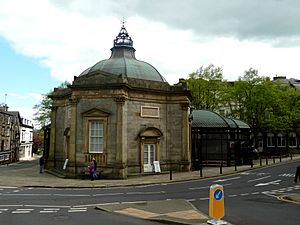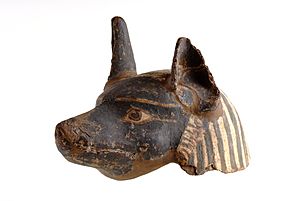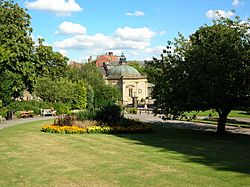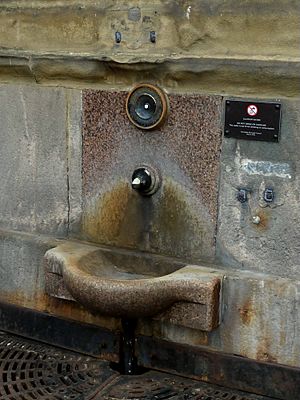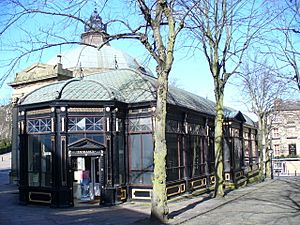Royal Pump Room, Harrogate facts for kids

The Royal Pump Room from the north-west
|
|
| Lua error in Module:Location_map at line 420: attempt to index field 'wikibase' (a nil value). | |
| Established | 1953 |
|---|---|
| Location | Harrogate, North Yorkshire, England |
| Type | Local museum |
| Key holdings | Anubis mask, artefacts and gifts from Russian Royalty. The Holland-Child Collection of predominantly Leeds made Creamware ceramics. Artefacts from Roman, Etruscan, Ancient Greek, Babylonian and South American cultures |
| Collections | Archaeology Social history |
| Collection size | 20,000 items |
| Owner | North Yorkshire Council |
The Royal Pump Room is a special old building in Harrogate, North Yorkshire, England. It's known as a Grade II* listed building, which means it's very important historically. Today, it's home to Harrogate's museum, run by North Yorkshire Council.
Long ago, it was a place where people came to drink special spa water from a natural spring. This water was believed to be good for health. The building is in the middle of Harrogate, across from the Valley Gardens park. It has an old stone part built in 1842 and a newer glass part added in 1913. People visited the Pump Room to drink the sulphur water and to meet friends.
The Royal Pump Room Museum
The Royal Pump Room became a museum in 1953 after being updated in the early 1950s. It is still owned and run by North Yorkshire Council. The museum had big improvements between 1985 and 1987. During this time, parts of the building, like the copper roof, were fixed. The original wellhead and water counter were also restored. New areas for displays and better visitor facilities were added.
Most of the museum tells the story of Harrogate as a spa town. A spa town is a place where people visit to relax and get better using special waters. The museum has about 20,000 items in its collection. Many of these items were given by local people, with some donations dating back to the 1850s.
Inside the museum, you can see recreated treatment rooms. These rooms show what Hydrotherapy facilities, like the Vichy baths, looked like in the nearby Royal Baths. There's also a special wheeled mahogany bath. This bath was used for sulphur peat baths and was found hidden for many years.
The museum also has a 19th-century Bath chair. These chairs were like old-fashioned wheelchairs. People could hire them to be pushed around Harrogate. They were very common in the 1800s and even into the 1920s.
Recently, some unique 'torpedo' shaped bottles were given to the museum. These bottles say "bottled at the Royal Pump Room, Harrogate." They show that the special sulphur water was bottled and sent all over the country. This was a big part of the Pump Room's importance.
The museum also shows off old clothes from its large collection. In 2014, some dresses were part of an exhibition. It showed how ancient Greek styles influenced fashion in the 1800s and 1900s.
Another important part of the museum is its collection of items from the Ancient World. The museum is famous for its Ancient Egyptian and Ancient Greek artifacts. These were collected by local people like Robert Ogden. The Egyptian collection includes a well-preserved sarcophagus (a stone coffin). It also has a rare cartonnage mask of Anubis, ancient gravestones, and pottery.
Special Exhibitions at the Museum
The museum often has special exhibitions. These shows use items from the museum's own collection and things borrowed from other places. For example, in 2014, there was an exhibition about World War I. It showed many items and memories from local people who fought in the war.
In late 2013, the Royal Pump Room displayed costumes from the TV show Downton Abbey. This exhibition was very popular with visitors.
Fun for Children and Young People
The museum welcomes many school groups from around Yorkshire. It has a good education program that fits with the National Curriculum for England. The museum offers workshops on topics like Egyptology, old toys, and local history. The nearby Mercer Art Gallery has a special room for school activities. Sometimes, actors in historical costumes visit to teach children about the past.
For families, there is a children's activity area. This area has coloring sheets, activity backpacks to borrow, and quiz sheets. During the summer holidays, the museum holds special sessions. Children can handle objects and take part in other fun learning activities.
History of the Royal Pump Room
How Harrogate's Special Waters Were Found
The first special well in Harrogate was the Tewit Well. It was found by William Slingsby in 1596.
By 1626, people were already using the water from Tewit Well for health reasons. A doctor from York, Edmund Deane, called it "The English Spa." He compared it to Spa in Belgium, which was already famous for its healing spring water.
The Old Sulphur Well Site
The Royal Pump Room was built over a natural spring called the Old Sulphur Well. This well has the most sulphur of all Harrogate's springs. Its water was called Strong Sulphur Water.
For about 60 years, a woman named Betty Lupton (who lived from about 1760 to 1843) served this special water. She retired in 1843, just as the Pump Room was finished. Betty was known as 'The Queen of the Well'. This was an honorary title given to women who served water at the Old Sulphur Well. These water servers were chosen and crowned every May.
Today, visitors to the museum can look down into the basement. There, they can see an 18th-century stone well-head for the Old Sulphur Well. It has a unique design with arches and a tent-like roof. This roof was meant to protect a marble basin underneath. In 1986, another old well shaft from the 1700s was found and reopened during museum renovations.
The First Royal Pump Room Building (1842)
The first Pump Room building was designed by Isaac Thomas Shutt. It was shaped like an octagon and had columns. It was built to hold 150 people. The building was finished in 1842. It cost about £2,249 and 7 shillings, which was a lot of money back then.
This building was the first big project for the Harrogate Improvement Commissioners. Their goal was to create a proper building for the Old Sulphur Well. The old structure that was there before was moved to cover the Tewit Well.
The Pump Room has four sections with windows and fancy Corinthian pillars. On one wall, there's a Latin saying: Arx celebris fontibus. This means "A citadel noted for its springs." The roof is shaped like a dome and is covered with copper tiles. In the center of the roof, there's a "lantern" that lets light into the building.
Drinking the Waters and the Outside Tap
In the Pump Room's busiest days, visitors would arrive early in the morning. They came between 7 and 9:30 AM to drink one or two glasses of the sulphur water before breakfast.
They would pay an attendant for their water, which was served in glasses from a wooden counter. It cost 1 shilling for one person to drink the water for a week. A family could drink for the same time for 4 shillings.
However, a law from 1841 said that Strong Sulphur Water had to be free for those who couldn't afford it. To follow this rule, the Pump Room had an outside tap. Anyone could use this tap for free at any time. After 9:30 AM, the inside service stopped, and the outside tap was the only way to get the water. An attendant used to watch over the tap.
This outside tap still exists today and still works. However, it's not safe to drink the water from it now.
The Pump Room Becomes Popular
During its popular years, music concerts were often held inside the Pump Room to entertain visitors.
People from all over Great Britain and even Europe came to drink the water. In the 1800s, sulphur water was thought to help with illnesses like gout and lumbago. Drinking the water at the Royal Pump Room was a key part of what was called "The Harrogate cure." Visitors also went to Harrogate's Royal Baths for other treatments, like hot mineral baths and mud baths. Rest, exercise, and relaxation were also important parts of this "cure."
More People Visit Harrogate Spa
The number of people drinking Harrogate's spa waters grew very quickly in the mid-1800s. For example, in 1842, about 3,778 visitors came to drink the water. By 1867, this number jumped to 11,626. At its peak in the late 1800s and early 1900s, the Pump Room saw about 15,000 visitors each year.
The 1913 Annexe Building
Because so many people were visiting, the Pump Room needed to be bigger. By the early 1900s, it was often too crowded. A small temporary building was put up first, but it didn't solve the problem. So, Harrogate Corporation decided to add a permanent extension.
Around 1912–1913, a new annexe (extension) was built. It was designed by Leonard Clarke (architect). This new part was made mostly of glass and had a roof with fancy copper 'fishtail' tiles. These tiles matched the copper roof of the original building. The Lord Mayor of London, David Burnett, came to Harrogate to open the annexe on June 7, 1913.
Sadly, just a year after the annexe opened, World War I began. This caused a huge drop in visitors to Harrogate. The Pump Room never got back its pre-war visitor numbers, even after peace returned.
Later Years and Closure
Even though 259,000 visitors came to Harrogate in 1925 specifically to drink the spa waters, the Royal Pump Room and other wells started to become less popular. The Great Depression and its economic problems also affected visitor numbers. Also, new ideas in medicine and changes in social customs meant fewer people came to "take the waters."
However, in August 1939, just weeks before World War II started, the Pump Room was still very busy. The roads outside were even closed in the mornings. This allowed guests to safely cross with their sulphur water glasses to tables set up outside. Newspaper sellers brought carts of newspapers to sell to customers.
These scenes, captured in an old film, show that the Royal Pump Room was still important in 1939. It brought in money for Harrogate. It is believed that the Pump Room closed around the start of World War II. This might have been because the government ordered public places where many people gathered to close.
After the war, even though some visitors still liked the Pump Room, the decision was made to stop pumping water. The building was used as a storage place and sometimes as a cafe or restaurant. But by the early 1950s, it was decided that the Pump Room would become Harrogate's new museum.
Famous Visitors to the Royal Pump Room
- In 1858, the famous writer Charles Dickens visited the building. He signed the visitor's book. He wrote that Harrogate was "the queerest place, with the strangest people in it, leading the oddest lives of dancing, newspaper-reading and dining."
- In 1911, Tsarina Alexandra of Russia, who was the wife of the Russian Emperor Nicholas II of Russia, visited the Pump Room.
- On December 2, 1987, the Duke of Gloucester officially reopened the Royal Pump Room Museum. A stone plaque on the wall remembers this event.
- In 2013, actor Jim Carter, who was born in Harrogate, gave a talk at the museum. He spoke about his life and acting roles.
See also
- Grade II* listed buildings in North Yorkshire (district)
- Listed buildings in Harrogate (Low Harrogate Ward)


